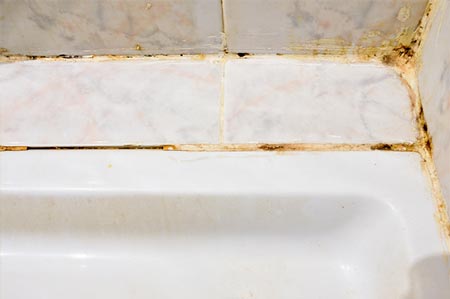Blog
What You Should Know About: Mould Removal & Remediation
Most people know that mould (AKA: “mold”) relies on moisture to grow, but not everyone realizes that even a minor water leak or slightly too much humidity is all that is needed for household mould to take hold – even in drier climates like we have here in Calgary.
Yet while there are many different types of mould that can crop up in your home or workplace, you can be sure of one thing: it should not be there.
Residential mould has been around for as long as, well, residences have existed. Depending on the climate and terrain in which the mould occurs, it can spread quickly (sometimes within the span of a day or two) or it can creep its way into the cracks, crevices, and small crannies of your living and/or work spaces.

Much like mould on a piece of food, once it appears it can progress very quickly.
Alberta Fire & Flood is Calgary’s trusted mould inspection, removal, and remediation company. We have been helping Albertans for decades with mould identification and recovery, and are honoured to be the mould removal specialists of choice for many local long-term care facilities, schools, and professional organizations throughout southern Alberta. Rest assured, you can trust us to address all of your mould infestation concerns.
We’ve created a collection of the top facts you should know about mould in Calgary and southern Alberta, including the most common forms of indoor mould and what to do (and not to do) in treating and sanitizing indoor mould infestations.
1. Most mould is not lethal, but it can certainly cause adverse health effects.
The word “mycotoxins” gets thrown around a lot in the mould remediation business, but what exactly is a mycotoxin?
Mycotoxins are harmful compounds that are naturally produced by moulds, yeasts, and mushrooms. There are two mould species that are mainly responsible for the myctotoxins that most commonly pose a threat to human and animal health: Fusarium and Aspergillus. [1]
According to the NCCEH,
[E]xposure to mould . . . in indoor environments is associated with asthma (both development and exacerbation), upper respiratory tract symptoms, cough and wheeze, hypersensitivity pneumonitis in susceptible people, respiratory infections, bronchitis, and eczema.[2]
While the vast majority of indoor moulds will not produce the kind of mycotoxins that cause serious and long-term health hazards, they can (and often do) cause lung irritation, and allergic & hypersensitivity reactions.
Other things that impact a person’s physiological response to mould include age, health & immune status, simultaneous exposures, and genetic factors.
2. Removing Mould Can Require More Than Just Some Bleach & Elbow Grease.

If you simply have a case of mould growing on the grout of your shower stall then maybe all that is needed is a bleach solution and strong scrubbing. But even then, it’s a wise move to make sure that the excess moisture that caused the superficial grout mould hasn’t permeated into the inside walls of your bathroom(s).
The Government of Canada suggests that you seek advice from a qualified professional to examine the condition of your home for the presence of mould.[3] As experienced Calgary mould removal and remediation professionals, we can give you just as many anecdotes of folks who thought they only had superficial mould but discovered otherwise as we can of folks who really did just have gross grout.
As with many other important things in life: When in doubt, call a professional!
3. Do You Need To Air Test For Mould?
Mould is a natural part of the environment and, as a result, there are always mould spores in the air. As such, any mould spores detected in an air test will not always be indicative of a mould problem in your home.
That said, there are certain specific examples where air testing for mould is absolutely necessary. These examples include:
- Protective environment rooms for individuals who are severely immunocompromised (such as those who have received hematopoietic stem cell transplants)[4]
- Property owners who want to have a “Repair Order”, “Unfit for Human Habitation Order”, or “Notice of Health Hazard” from Alberta Health Services removed. [5]
Outside of that, there are certain things for which an air test for mould can be useful. These things include:
- Whether or not there are elevated levels of mould spores in your environment
- The quality of your indoor air
- The species of mould present
However, an air test for mould will not tell you where to find the mould, how it’s spreading, nor will it tell you the underlying cause of its presence.
4. What Defines a “Small”, “Medium”, and/or “Large” Area of Mould?
When choosing a mould clean up plan, it’s important to know whether you’re dealing with a small, medium, or large area of mould coverage.
Health Canada defines a “small” area of mould as “no more than three patches of mould, with the total area staying within one square metre.” [6]
A “medium” sized area of mould is more than three patches of mould, and where the total combined area is between one and three metres. It is strongly recommended that medium-sized mould patches receive an expert assessment to determine the best mould removal method for dealing with them.
A “large” area of mould is where a single patch of mould is larger than three metres squared. It is important to note that, for your health and safety (and those with whom you reside), “large” areas of mould should be removed by a qualified mould remediation professional (such as Alberta Fire & Flood).
5. Do You Really Have to Physically Remove ALL Mould-Damaged Materials?
Mould removal best practices are that materials damaged by mould are to be safely removed and disposed of, either by you or by a qualified mould removal professional. The only exception to this is if the mould growth is only on smooth, non-porous surfaces (such as tiles).
Any other instances of mould need to be dealt with by physically removing the materials in/upon which it occurs and disposing of them. To do this safely, you will need either a mould removal specialist or to don protective gear in the form of safety goggles, disposable N95 masks, and disposable household cleaning gloves (depending on the situation).
6. How Do You Prevent Mould from Forming?
Because mould is such a tenacious fungus, an ounce of prevention really is worth a pound of cure. There are simple things you can do to prevent the occurrence of mould in your home, which include:
Ventilate:
- Having and using a properly working exhaust fan in areas prone to high humidity/moisture levels, such as the bathroom. Keep this fan running for a minimum of a half hour after finishing a shower or hot bath.
- Ensure that any ventilation is effectively and properly sealed, reinforced, unobstructed, and in good working order.
Repair:
- Repair or replace any open or damaged surfaces, such as linoleum, tiles, grout and caulking, and ceiling stucco.
- Stay on top of your plumbing by promptly repairing any leaks or faulty pipes (improperly remediated water damage is a leading cause of mould infestations!)
- Check that all water drains (sink, bathtub/shower, washing machine, dishwasher, etc.) are draining properly.
Condensation:
- Keep the walls of your bathroom dry and clean. You can do this with a clean, basic towel or a squeegee.
- Keep your curtains, blinds, and shutters open in order to allow air to flow freely – window coverings could trap moisture and create condensation on and around the windows.
Everything Else:
- If you have a particularly moisture prone or humid area in your home then consider using a dehumidifier there.
- Keep all areas (including storage) free of clutter and debris.
- Store firewood outside.
- Remove footwear upon entering the home.
- Vacuum frequently using a HEPA filtered vacuum.
Hopefully this article has helped improve your understanding of mould, its causes, health impacts, as well as given you insight into the best practices for mould removal and remediation. If you have any questions, or if you would like to talk to an expert about your specific mould-related concerns, then please feel free to contact us here at Alberta Fire & Flood! One of our mould removal experts would be happy to help you in whatever way we can.
[1] https://www.greenfacts.org/en/mycotoxins-aflatoxins-fumonisins/l-2/index.htm
[2] https://www.ncceh.ca/sites/default/files/Mould_and_Health_Effects_Jul_2012.pdf
[3] https://www.canada.ca/en/health-canada/services/publications/healthy-living/addressing-moisture-mould-your-home.html
[4] https://www.albertahealthservices.ca/assets/healthinfo/ipc/hi-ipc-immunocompromised-patients.pdf
[5] https://www.albertahealthservices.ca/assets/wf/eph/wf-eh-fungal-air-testing-for-mould-contaminated-buildings.pdf
[6] https://www.canada.ca/en/health-canada/services/publications/healthy-living/addressing-moisture-mould-your-home.html
Facts about True HEPA Filtration
With so many brands claiming that their products have HEPA filtration and/or are “HEPA certified”, you may be wondering what all the fuss is about. In this post, we discuss all things HEPA-filtration – read on to learn the ins-and-outs of HEPA filtration.
Why Choose HEPA Filtration?
According to the Centers for Disease Control and Prevention (CDC) Guidelines for Environmental Infection Control in Healthcare Facilities, HEPA filtration is required for the capture of microbial spores and other contaminants that can potentially cause fungal infections and Aspergillosis. Here at Alberta Fire & Flood, we use a variety of HEPA filtration products – including the PREDATOR® Portable Air Scrubber.
All PREDATOR® Portable Air Scrubbers are equipped with high-efficiency, HEPA filters that are tested and certified to remove at least 99.97% (9,997 out of 10,000) of particles 0.3 microns (0.000012-inch) in size. To put this in perspective, fungal spores are typically five to 25 microns in size.

Predator Air Scrubber
Testing and Certification by Independent National Laboratories
Abatement HEPA filters meet Institute of Environmental Sciences and Technology standard for Type A 99.97% efficiency HEPA filters. To meet this standard, each and every completed Abatement HEPA filter must be tested for leakage and resistance, to detect any leaks in the media or between the media and the frame or other problems that can compromise the integrity of the completed filter. Test results must be shown on a label on the filter frame. Abatement filter frames are metal or plastic. The CDC Guidelines state that: “Wood can compromise the air quality if it becomes and remain wet, allowing the growth of fungi and bacteria.” Abatement filters also meet UL900 flammability requirements.
How often do Abatement HEPA filters need to be changed?
The size and concentration of airborne contaminants, temperature, humidity conditions and duration of use determine how often filters need replacement. As the filters become loaded with particulate matter, the airflow capacity of the unit decreases and the static pressure differential across the filter increases.
Abatement PREDATOR Portable Air Scrubbers are equipped with easy-to-read filter change indicator lamps that illuminate when filters should be replaced. Unlike gauges, these lamps do not require operator interpretation or calculations. Average filter life (with continuous operation):
- Primary filter: 1 day
- Secondary filters: 3-7 days
- HEPA filter: 500 to 1,000 hours
What does the term HEPA mean?
HEPA is an acronym for “High Efficiency Particulate Air” or “High Efficiency Particulate Arrestance.”
Definition: What is Arrestance? Arrestance is the measure of the ability of an air filtration device to remove a synthetic dust from the air.
This acronym refers to a filter that is manufactured, tested and certified to meet Institute of Environmental Sciences and Technology (IEST) construction, performance and certification standards as currently published in IEST RP-CC001.4.
What is it that makes HEPA filters so efficient?
The ultra-fine, glass-fiber medium captures microscopic particles that can easily pass through other filters by a combination of diffusion, interception and inertial impaction. To qualify as a Type A HEPA filter, the filter must capture at least 99.97% (9,997 out of 10,000) of particles 0.3 microns in size–about 300 times smaller than the diameter of a human hair, and 25 to 50 times smaller than we can see. To a HEPA filter, catching a one-micron particle (1/1,000,000 of a meter) is like stopping a cotton ball with a door screen.
Are all filters made with HEPA filter media HEPA filters?
No. Manufacturing a filter with HEPA filter media does not mean that the filter itself meets true HEPA efficiency requirements. Serious filter leakage can go undetected if filters are not individually tested and certified at the end of the manufacturing process. Even the tiniest pinhole leaks in the media or breach of the seal between the media pack and the filter frame can cause the filter to fail IEST requirements. The testing requires very specific procedures using a thermally generated mono-dispersed aerosol and a laser particle counter. Some regulations also require field-testing by the user prior to going into service and periodically thereafter.
Why is the testing done with a 0.3-micron particle size test aerosol?
Filter efficiency studies have shown that 0.3-microns is predominately the “Most Penetrating Particle Size (MPPS)” for HEPA filter media. Efficiency is typically greater than 99.97% against larger or smaller particle sizes. Particles larger than 0.3 microns are typically more easily trapped, or intercepted, by the media. Smaller particles often lack sufficient mass to penetrate the media.
Is a “HEPA-Type” filter the same as a HEPA Filter?
No. In fact, the differences are huge. According to the American Lung Association, filters classified as “HEPA-type” filters may capture as little as 55% of 0.3-micron particles (5,500 out of 10,000). By this definition, the true HEPA filter could be more than 1,800 times as efficient as the “HEPA-type” filter.
Does HEPA filter efficiency decrease as the filter gets dirty?
No. Filter media with an electrostatic charge and other air purification technologies can experience substantial loss of efficiency as they become dirty. Exactly the opposite typically happens with HEPA filters. The dirtier it gets, the more efficient it can become.
HEPA filtration is discussed throughout many of the seminars at the Restoration Academy. Whether the seminar is on mould, fire and smoke, bed bugs, Hantaviruses, etc., learners are made aware of the HEPA Sandwich technique that Alberta Fire and Flood uses to ensure that their clients are moving back into a healthy and safe home and business environment.
 Your HEPA sandwich machine
Your HEPA sandwich machine
The Bed Bug Armageddon

Bed bugs have been a household pest issue for more than 3,300 years, dating back to ancient Egypt. They were first brought to the Canada and the United States by early colonists, where they thrived for many decades. However, by the 1950’s, bed bugs had been all but eradicated in the developed world, thanks to the availability of new pest control products, coupled with the widespread use of vacuums and washing machines which helped to control the spread of infestations in living spaces.
Several factors led to the resurgence of bed bugs beginning in the late 1990’s; increased international travel, more targeted pest control products and methods and a lack of public awareness about pest prevention methods. However, today the wide spread of bed bugs has been identified as people purchasing second hand furniture and bringing it into their homes. The homeowners sleep soundly tucked in their warm beds as the bed bug feast on their unsuspecting bodies.
SLEEP TIGHT…DON’T LET THE BED BUGS BITE!
For more information, contact:
Patrick Martens
Hoarding – a Problem through the Ages
Hoarding is now recognized by the medical community as a psychological disorder. It appears to be more prevalent in first world nations as compared to more impoverished areas of the globe. While it has only recently been defined and studied as an illness (mostly in the last 20 years), it has been recognized as a problem for nearly a millennium. Whether it is a mental disorder, spiritual problem, or both, hoarding tends to result in people who are withdrawn and isolated from society.
The advent of high-rise buildings has increased the risk that hoarders pose. In their own single family dwelling, the hoarder’s penchant for saving all manner of items, useful and useless, has negative effects on them and their closest family/acquaintances. In multi-family structures hoarders pose a risk not only to themselves, but to their neighbors. Several high-profile fires in multi-story buildings around the world have been attributed to hoarders. For example: More than 600 tenants to share $4.85 million in compensation for lost property and injuries after a huge fire at 200 Wellesley St. E. three years ago. The fire started on the balcony of a hoarder.
The amount of combustible material, inability of first responders to move throughout the structure when trying to address a problem, and the additional stress that the weight that the hoarded material places on the load bearing members of the structure (particularly when saturated with water from the firefighting effort) are all serious safety concerns.
Given all this, it is likely that more cases of hoarding will be identified at earlier stages. The trend, in both Canada and the USA, is to move aggressively with doctors and the courts to get individuals the medical and psychological help that they need, as well as addressing the buildup of materials. This is where trained cleaning and restoration contractors can be invaluable.
Hoarder cases typically require a combination of skills, including content management, disposal services, disinfecting, cleaning, and often mould remediation. Although these skill sets and experience with such activities are common among the staff members of cleaning and restoration organizations, putting them all together to address a hoarder situation can be a bit tricky.
One of the most challenging aspects of dealing with hoarder cases is the fact that the cleaning and restoration contractor has to balance the interest of a number of materially involved parties, including the hoarder, family members, provincial health officials, doctors, psychologists, social workers, and others. Understanding who has the ultimate responsibility for allowing work to move forward or how to address potentially valuable items that are uncovered during the restoration of a hoarding facility needs to be sorted out before the project begins. Another key point is to realize that because of the many potential physical and health dangers associated with hoarders, such projects are classified as forensic restoration work and should be conducted in conformance within the guidelines as set out by the Restoration Industry Association.
The actual work of assisting hoarders in reclaiming their lives typically involves individuals who can tolerate wearing personal protective equipment (PPE) for extended periods of time, are physically fit so they can move the various items, and have an eye for detail so that they don’t miss the jewelry, cash, collectibles and other valuables that are buried in the pile. Generally, cleaning and restoration contractors are best situated to handle hoarding situations because they not only have the ability but the heart to complete projects properly. They are used to dealing with individuals who are suffering through some of the most devastating situations in their lives, and for hoarders, the removal of their “precious possessions” is just as traumatic as a major fire or flood is for other clients.
For more information:
Contact
Patrick Martens
Hydroxyl Radicals: The Truths
Truth #1: The lifespan of UV optics varies.
People often ask how long the UV optics last. It is true the answer could be 8,000 hours or more. However, this is very misleading. UV light gradually loses power over time. The patented technology is based largely on the power of these optics. Yes, the optics will stay lit for 8,000 hours or more, but the machines become weaker and weaker the longer they run. Jobs that used to take three days to complete may now take four or more. In this industry, when dealing with moderate to severe odours, it is recommended that optics be replaced after the hour meter shows 4,000 hours of usage.
Truth #2: Coverage area varies on a job-to-job basis depending on several factors.
What size area will one machine cover? Since every odour project is unique, there are always variables to consider such as the layout of the structure, the number of contents on site, the severity of the odour, and how quickly the odour should be eliminated.
A general rule of thumb is that one machine will cover 1,000 – 1,500 square feet with ceiling height up to about twenty feet or so. Some experts have indicated a machine will treat “up to” 40,000 cubic feet or more. Could it? Perhaps, but treatment would take a long time with the machine having to be moved around continuously.
Truth #3: Ozone is generally faster, but unlike ozone, crews can keep working while hydroxyl generators run eliminating interruption and down time.
Lastly, people usually want to know how long it takes hydroxyls to work compared to ozone. Scientifically, hydroxyls are one million times more reactive than ozone. This means that they will disassemble a much larger range of odours and VOCs. However, the time it takes to do this is determined by the concentration of oxidants used. The average ozone generator compared to the average hydroxyl generator will be faster. For example, if it took the ozone generator 24 hours to work, the hydroxyl generator will take 36 hours.
You can let adjusters know that the hydroxyl generator can be running while the physical work is being done.. So, the job is now streamlined and the odour will be gone sooner. This can now decrease or eliminate the need for ALE or business interruption. It is also important to remind them that, unlike ozone, hydroxyls will not damage sensitive materials and can be run while the treatment space is still drying.
This should address the more frequent questions. We’re always available to answer more questions and provide training classes for interested parties.
Final Comments
There are three levels that one can take in using hydroxyls in odour remediation. These are:
- Aggressive which has people working with the hydroxyls running in the same work area;
- Moderate which has people working with the hydroxyl generators in a limited capacity; and
- Conservative where no one is working in the same area as a hydroxyl generator.
The Conservative approach is what we have taken at Alberta Fire and Flood. In this way, we can be assured to eliminate all the confusion around the interaction between hydroxyls and people.

Everything you can see in this daycare was effectively deodorized of smoke odour with hydroxyls.

Containment was built over the student lockers, then hydroxyls were injected. Had that deodorization techniques not been available all the lockers would have to be removed.
Hydroxyl Radicals: The Myths
Hydroxyl generators were introduced to the disaster restoration industry in 2008 as a new and disruptive technology, and have stimulated many questions and discussions throughout the years. While contractors will quickly confirm how effective they are, there are still a variety of questions.
- Is it true you need 60% humidity?
- How long do the ultraviolet (UV) optics last?
- What size area do the machines really cover?
- How do we know if they’re actually safe?
- Are all hydroxyl generators basically the same?
- Etc, etc, etc!
The Myths
Myth #1: All hydroxyl generators require 60% humidity to be effective.
To start, there is a statement in the industry that all hydroxyl generators require 60% humidity to be effective. This is a myth and would render hydroxyl generators useless in many parts of the United States and Canada. Hydroxyl generators using the patented technology will be effective with humidity as low as 5%. Contractors should never have to add humidity for their hydroxyl generators to work, particularly since this is counterproductive to most projects they are on. It is true that humidity plays a part in the chemical reactions that occur to create hydroxyl radicals (and oxy and peroxy radicals). However, any change in humidity will not have a noticeable effect on the generator’s ability to eliminate odours and certainly won’t determine if the machines work or not.
Myth #2: You need a strong fan to blow the hydroxyl radicals as far as possible before they’re gone since their half-life is a fraction of a second.
This is false, and would never work if this strategy had to be used on projects. Instead, the patented technology is able to continuously create new hydroxyl radicals outside the chamber of the machine. The science behind how this works is quite complex, but chemists refer to this as a chain reaction or a cascade effect. This means new hydroxyl radicals, as well as oxy and peroxy radicals, are being created outside the machine and throughout the treatment space due to a multitude of chemical reactions. The ability to create this chain reaction is a critical element of the patented technology, and allows contractors to eliminate odours that have been adsorbed in both the contents and structure. Additional air movers are often helpful to distribute hydroxyls into hard to reach areas. Many contractors have been very creative in reaching difficult areas, but those detailed tips are best in a different article.
Myth #3: There isn’t any documented, real-world research you can use to prove to a homeowner or adjuster that hydroxyl generators actually work and are safe.
That’s false; there is significant documentation out there and this is easily accessible! Testing has been performed over the years by reputable third-party companies like Underwriters Laboratory (UL), Lovelace Respiratory Research Institute, the FDA, Comparative Biosciences, and Wonder Makers Environmental. Results provide information that show how many hydroxyls are produced and how much ozone is produced.
These studies were only performed on the patented technology, and are powerful tools to confirm both the safety and efficacy. They will certainly help answer the questions that may be received from both customers and adjusters.
Myth #4: While there are now different brands of hydroxyl generators, they are basically the same.
This is also false. There are two types of hydroxyl generators in the disaster restoration industry, and they use very different processes to create hydroxyls; as a result, the strength and capabilities are very different.
One uses high-powered UV light with multiple wavelengths to generate hydroxyls that exit the machine and create a chain reaction throughout the treatment space. This technology is unique because it enables the treatment of not just the air, but more importantly, the contents and structure where the odours have been adsorbed. They are very powerful and it is important to follow the manufacturer’s operating instructions restricting usage in small, occupied areas. These generators are used in conjunction with an air mover.
The other process used to produce hydroxyls is called photocatalytic oxidation (PCO), which is primarily used for residential air purifiers and many different brands can be found online. The PCO process uses a titanium dioxide coated surface and low-powered UV light, whereby only the VOCs in the air that pass through the machine and come in contact with this coated surface can be treated. This PCO process does not produce hydroxyls that exit the machine, and therefore cannot eliminate the odours that have been adsorbed by the contents and structure. As you can see, while the name hydroxyl generators are the same, the differences are significant.


